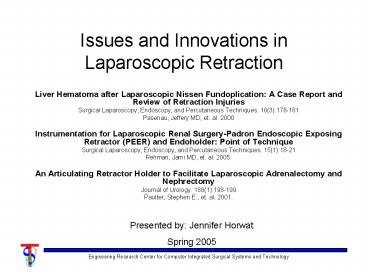Issues and Innovations in Laparoscopic Retraction - PowerPoint PPT Presentation
1 / 17
Title:
Issues and Innovations in Laparoscopic Retraction
Description:
Engineering Research Center for Computer Integrated Surgical Systems and Technology ... Journal of Urology. 188(1):198-199. Paulter, Stephen E., et. al. 2001. ... – PowerPoint PPT presentation
Number of Views:161
Avg rating:3.0/5.0
Title: Issues and Innovations in Laparoscopic Retraction
1
Issues and Innovations in Laparoscopic Retraction
- Liver Hematoma after Laparoscopic Nissen
Fundoplication A Case Report and Review of
Retraction Injuries - Surgical Laparoscopy, Endoscopy, and Percutaneous
Techniques. 10(3)178-181 - Pasenau, Jeffery MD, et. al. 2000
- Instrumentation for Laparoscopic Renal
Surgery-Padron Endoscopic Exposing Retractor
(PEER) and Endoholder Point of Technique - Surgical Laparoscopy, Endoscopy, and Percutaneous
Techniques. 15(1)18-21 - Rehman, Jami MD, et. al. 2005.
- An Articulating Retractor Holder to Facilitate
Laparoscopic Adrenalectomy and Nephrectomy - Journal of Urology. 188(1)198-199
- Paulter, Stephen E., et. al. 2001.
Presented by Jennifer Horwat Spring 2005
2
Smart Organ Retractor ProjectMentors Greg
Fischer and Mark Talamini, MDPartners Sunipa
Saha and John Yu
- Developing manual and laparoscopic retractors
with both force and ischemia sensors on each - Conducting experiments with both retractors to
relate force and ischemia over time - Improving current system with a pattern of
sensors and a full calibration to standard
pulse-oxidation values
3
Paper Selection
- Liver Hematoma after Laparoscopic Nissen
Fundoplication A Case Report and Review of
Retraction Injuries - Instrumentation for Laparoscopic Renal
Surgery-Padron Endoscopic Exposing Retractor
(PEER) and Endoholder Point of Technique - An Articulating Retractor Holder to Facilitate
Laparoscopic Adrenalectomy and Nephrectomy
4
Summary of Problem
- Technical difficulties of laparoscopic surgery
- Reduced haptic feedback
- Loss of 3-D visualization
- Constricted field of view
- Narrowness of instruments
- Often results in application of excessive force
on the retracted tissue
5
Key Results
- Recognition of retraction as a significant source
of morbidity in laparoscopic surgery - Visual observation of tissue to monitor ischemia
- Successful use of mechanical systems to maintain
constant force and retractor position
6
Case Report and Review of Retraction Injuries
- Patient-55 year old woman with history of GERD
- Grade 2 esophagitis established with endoscopy
- Abnormal 24-hour pH monitoring
- Obese (165 cm, 80 kg)
- Left lobe of liver retracted by
- epigastric 5mm trocar during procedure
- Patient returned one week after
- discharge with epigastric abdominal pain
http//www.peterjurek.com/rbv_site/web_pages/troca
r.html
7
Case Report and Review of Retraction Injuries
- CT scan 3.8cm x 2.6cm hypodense mass
Pasenau, et al (2000)
8
Case Report and Review of Retraction Injuries
- Observations
- Technical difficulty of obtaining adequate
exposure - Distraction of assistant
- Aggressive retraction may lead to change in liver
color, a possible indicaiton of ischemia - Recommendations
- Monitor color of liver throughout procedure
- Careful evaluation of position of retractor at
intervals
9
Case Report and Review of Retraction Injuries
- Safe retraction depends on
- Type of retractor
- Size of patients left lobe
- Amount of force applied on retractor
Pasenau, et al (2000)
10
PEER and Endoholder System
- Problem
- Excessive force inadvertently exerted on anatomic
structures - Challenge for assistant to maintain force over
time - Goal
- To reduce technical difficulty of laparoscopic
surgery - Solution
- Use articulating instrument holder (endoholder)
and Jarit Padron Endoscopic Exposing Retractor
(PEER)
11
PEER and Endoholder System
- PEER
- Two telescoping blades
- Fully rotatable with locking
- ratchet handle
- Endoholder
- Base rod
- Flesible extension arm
- Precision clam
- Table attachment
Rehman, et al (2005)
Rehman, et al (2005)
12
PEER and Endoholder System
- Advantages
- Decreases technical difficulty
- Reduced operative time
- Disadvantages
- No measure
- of force
Rehman, et al (2005)
13
PEER and Endoholder System
- Performance
- Provides safe and reliable exposure
- Used in more than 200 cases
- Complications 1 minor liver laceration
- No record of hematoma due to ischemic injury
14
Clinical Use of Articulating Retractor Holder
- Articulating retractor held fan retractor
- Durable
- Stable
- Laparoscopic Nephrectomy
- Procedure has prolonged operative time
- Fatigue to human assistants
- Procedure would benefit from mechanical assistance
15
Clinical Use of Articulating Retractor Holder
- Results
- 111 laparoscopic cases performed
- Articulating retractor holder used in all right
liver retraction dissections and approximately
50 of left spleen dissections - Each case required only 5 minutes for placement
of port and insertion of retractor - No device failures or complications related to
either the retractor holder or the fan retractor
used
Pautler, et al (2005)
Pautler, et al (2005)
16
Relevance to Project
- Established two main objectives
- 1. Avoid excessive force
- Mechanical assistant does not prevent excessive
force from being used - No data and no standard for what constitutes
excessive force - Currently no measurement of force on any of the
laparoscopic tools discussed - 2. Monitor color of liver during procedure
necessary - Internally
- Relative oxygenation level
- Field of view issues solved with ischemic sensors
17
Possible Next Steps
- Combine the observations and work of the three
papers discussed - Observe color changes in tissue through pulse
oxidation with a mechanical assistant holding
retractor - Establish guidelines for force over time to avoid
ischemia and develop alert for high risk
conditions































